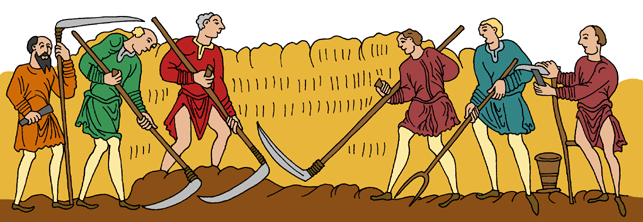|

|
|

What Everybody did
in Anglo-Saxon England

- Almost all Anglo-Saxons
were farmers.
- They spent most of their
time working on the land, growing food
and looking after animals.
- They mostly grew einkorn
(a type of wheat), rye, barley, oats, peas and beans.
- They used lots of
different wooden tools, like hoes, rakes, spades, billhooks
and forks.
- Some of the hardest work
was done when ploughing the fields (see picture above), before
sowing the seeds. This a usually done with a piece of
equipment called a 'plough'. Attached to a wooden frame is a
metal blade which is pulled through the soil by animals. This:
- digs a 'furrow' (a
line in the soil to plant seeds in)
- turns over the soil,
bringing the best soil to the top
- buries weeds and the
remains of the last crop so they can rot and fertilize it
- aerates the soil, making
pockets to hold water better
- Saxons used a simple
form of plough called an 'ard' or 'scratch plough'. This dug a
furrow, but did not turn over the soil and do all the good
things to it. In the 10th century, the plough was invented.
- Saxons also farmed
animals: mostly cows, sheep and pigs, but they also kept
goats, geese and chickens.
- They used them for meat,
milk, cheese, butter, eggs, wool, leather, tallow (for making
candles), bone & horn,
cooking fat and feathers. Cattle and horses were used for
transport. Donkeys were rare. Oxen were most important for
pulling the plough or ard.
- Saxon animals were
small: cows about 1.0-1.3m high and sheep about 50-70cm high.
Pigs were dark and hairy with pointy ears.

|
|

